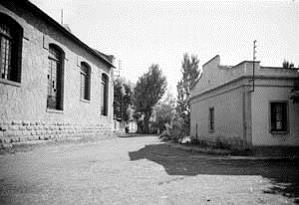PARDINYES
Name of the station: Pardinyes
Date of inauguration: 30th May, 1860.
Author: David Martínez
Origin and evolution
The neighbourhood of Pardinyes, in the city of Lleida, developed thanks to the creation of the city’s railway station, marshalling yard and maintenance workshops. All of this took place in the area called the “Recorrido”, which was where the railway workers built their homes.
Figure 1: Marshalling yard, 1920.

Source: Campo Roca photograph collection.
Figure 2: RENFE buildings. Housing constructed for railway workers, 1920.

Source: Campo Roca photograph collection.
Figure 3: The current RENFE building, 2013.

Source: David Martínez Herrera.
Thanks to the railway station, a number of important companies established premises in Pardinyes between 1949 and 1980. The most important of these included: the gas factory, in 1949; Arrocera del Segre, in 1951; the Rocafort workshops, in 1952; Los Silos, in 1958 and the Porta and Díez animal feed factories in 1960 and 1970, respectively. All of these premises became established in Pardinyes because of the railway and as a result of its passenger and goods carrying functions.
Figure 4: Rocafort workshops. These workshops were dedicated to repairing and restoring RENFE rolling stock, 1960.

Source: www.orvepard.org.
Figure 5: The “Los Silos” cereal factory, 1960.

Source: Campo Roca photograph collection.
Special features
The old amenities established in the neighbourhood of Pardinyes no longer have functions associated with the railway.
In some cases, their buildings have been rehabilitated and restored by the City Council; this has been the case of the former marshalling yard, which is now occupied by the Salvador Seguí Municipal Institute for Employment and by the Shalom workshop.
Figure 6: Workshops for repairing wagons and sleeping cars, in 1925. The building currently the Shalom workshops.

Source: www.orvepard.org
The Rocafort workshops originally repaired RENFE’S machinery and wagons, but they have since followed the same route as the marshalling yard and are no longer associated with the railway. The space that they used to be is now occupied by companies like Brico King.
Other spaces, such as that once occupied by the factory “Los Silos”, which produced cereals, have now been abandoned, although it is still possible to see what remains of their original premises.
Epilogue
It is significant to note how the railway has conditioned both the evolution of cities and of local society. Lleida, and particularly the neighbourhood of Pardinyes, owes much of its present appearance to its past uses.
The installations and infrastructure that were associated with the railway gave this part of Lleida its dynamism for growth and development.
